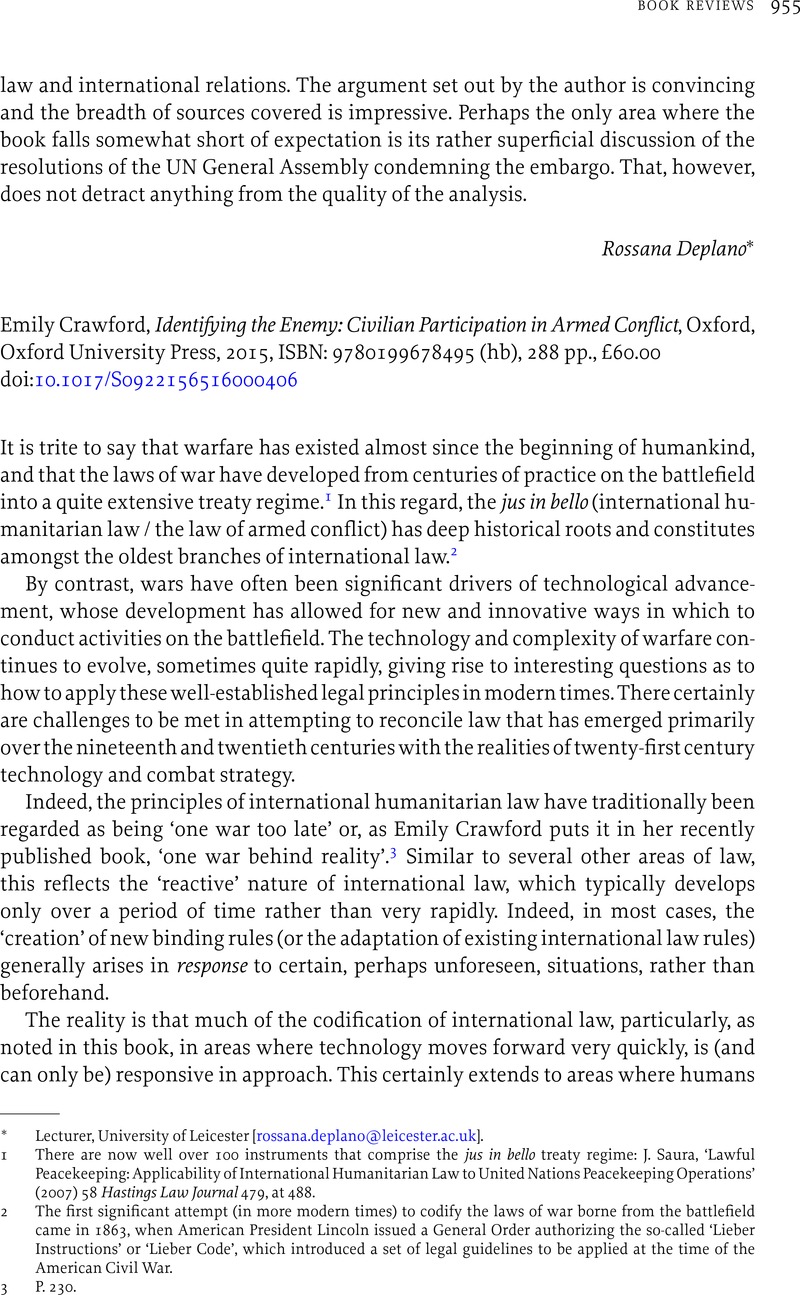No CrossRef data available.
Article contents
Emily Crawford , Identifying the Enemy: Civilian Participation in Armed Conflict, Oxford, Oxford University Press, 2015, ISBN: 9780199678495 (hb), 288 pp., £60.00
Published online by Cambridge University Press: 28 July 2016
Abstract

- Type
- BOOK REVIEWS
- Information
- Copyright
- Copyright © Foundation of the Leiden Journal of International Law 2016
References
1 There are now well over 100 instruments that comprise the jus in bello treaty regime: Saura, J., ‘Lawful Peacekeeping: Applicability of International Humanitarian Law to United Nations Peacekeeping Operations’ (2007) 58 Hastings Law Journal 479, at 488Google Scholar.
2 The first significant attempt (in more modern times) to codify the laws of war borne from the battlefield came in 1863, when American President Lincoln issued a General Order authorizing the so-called ‘Lieber Instructions’ or ‘Lieber Code’, which introduced a set of legal guidelines to be applied at the time of the American Civil War.
3 P. 230.
4 P. 1.
5 For a discussion, see S. Freeland, Addressing the Intentional Destruction of the Environment during Warfare under the Rome Statute of the International Criminal Court (2015), 141–50.
6 [1996] ICJ Rep. 226, para. 78.
7 P. 1.
8 P. 11.
9 This ‘negative approach’ as to what constitutes a civilian has been criticized as ‘vague, nebulous, and highly subjective’: Dorman, K., ‘Proportionality and Distinction in the International Criminal Tribunal for the Former Yugoslavia’ (2005) 12 Australian International Law Journal 83 Google Scholar, at 88 and the corresponding footnotes.
10 P. 24.
11 P. 233.
12 Pp. 24–5.
13 P. 233.
14 P. 49.
15 Manual on International Law Applicable to Air and Missile Warfare (2009).
16 P. 91.
17 P. 95.
18 P. 107.
19 Maogoto, J. and Freeland, S., ‘The Final Frontier: The Laws of Armed Conflict and Space Warfare’ (2007) 23:1 Connecticut Journal of International Law 165 Google Scholar, at 178.
20 Unlawful combatants may not be entitled to all of the protections that apply to lawful combatants under the relevant jus in bello treaties: see Ex Parte Quirin, United States Supreme Court, (1942) 317 US 1.
21 Watkin, K., ‘Controlling the Use of Force: A Role for Human Rights Norms in Contemporary Armed Conflict’ (2004) 98 American Journal of International Law 1 CrossRefGoogle Scholar, at 17.
22 Dissenting Opinion of Judge Lachs in North Sea Continental Shelf Cases (Federal Republic of Germany v. Denmark and Federal Republic of Germany v. The Netherlands) [1969] ICJ Rep. 3, 230.
23 P. 126.
24 P. 128.
25 P. 137.
26 P. 148.
27 P. 202.
28 For a discussion, see Freeland, S., ‘For Better or For Worse? The Use of “Soft Law” within the International Legal Regulation of Outer Space’, (2011) XXXVI Annals of Air and Space Law 409 Google Scholar.
29 P. 225.


